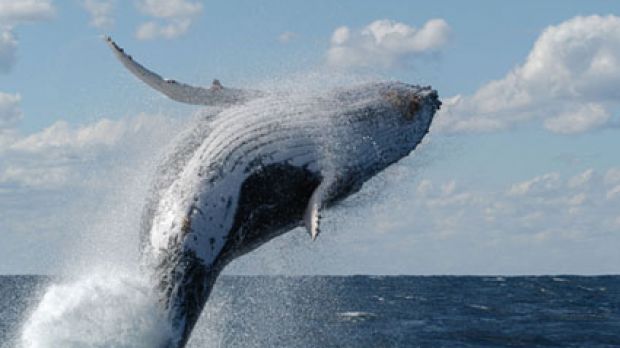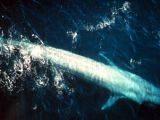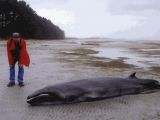1.Cetaceans (whales and dolphins) appeared 50 million years ago (the oldest known whale being Pakicetus), having (as revealed by DNA) a common origin with ?the hippopotamus (!). 40 million years ago whales were divided into baleen whales and toothed whales. The oldest known baleen whale is Mamalodon (that lived 25 million years ago in Australia). The first gigantic baleen whales appeared 5 million years ago.
2.There are 15 species of baleen whales and 74 toothed whales (42 are dolphins).
The largest whale (and ever existing animal) is the blue whale: up to 33 m (100 ft) in length and 181 tons, but the average size is 27-28 m (81-84 ft) in length and 150 tons (of which 50 tons are blubber (!), as the fatty layer can be 40 cm (16 inch) wide). The smallest baleen whale is the Pygmy Right Whale, 6 m (20 ft) long and 3 tons heavy. The largest toothed whale is the sperm whale, which can reach 18 m (60 ft) in length and 50 tons in weight.
Blue whale is solitary or lives in small groups of 2-3 individuals.
3.The large size of the whale is due to the food abundance in the sea and it is also a method of fighting the cold water of the sea (otherwise, they would lose a lot of heat in polar waters of 2-4 degrees C). The blubber layer can be 50 cm (1.5 ft) wide. The blubber is a food reserve but also a thermo-insulating layer in the cold waters where whales live (that's why stranded whales die of hyperthermy and dehydration). The fat is not fixed to the muscles, but very flexible, slipping over the muscles.
A whale weighing 60-70 tons delivers 20-25 tons of meat, 15-20 tons of blubber, while the fat rich skeleton weighs up to 15 tons.
The heart of a medium sized baleen whale weighs 700 kg (1,750 pounds), the tongue about 3 tons, the fatty liver one ton and the 3 m (9 ft) long stomach around 500 kg (1,250 pounds), requiring 1,200 kg (3,000 pounds) to be filled! The gut can be 250 m (833 ft) long and a blue whale eats 5 tons of food daily!
Blue whale's brain weighs 5 kg (12.5 pounds) while that of the sperm whale 7 kg (17.5 kg), representing the largest brain in nature. The head represents 40 % of the length of a right whale.
Whales have minute eyes: those of a blue whale's are no larger than a small plate.
4.The whales' lungs can store at each inspiration 5,000 liters of air. They usually breathe at every 15 minutes but they can hold their breath up to over an hour in the case of the sperm whale. The humpback whale can dive to 250 m (833 ft) for 20 minutes. The blue whale's exhaling blow can be 12 m (36 ft) tall! The blow can be heard 2 km (1.2 mi) away. In other whales it is 3 m (10 ft) high. In freezing water, the breathing rate is slower to keep the warm air inside.
Sperm whales dive at over 1,200 m (3,600 ft) depths and Cuvier's beaked whale (a type of toothed whale) holds the record for diving amongst any sea mammal: 1,900 m (6,330 ft) (this means 190 atmospheres) for one hour and 25 minutes. The bottlenose whales (Hyperoodon) dive for 2 hours at depths of 495 m (1,650 ft) in search of cephalopods. In toothed whales, the nitrogen from the blood is absorbed by the fatty substance from the bump of the head (melon).
5.Baleens are 300-660 keratin fringed plates hanging from the roof of the mouth, which can be up to 4 m (13 ft) long and weigh 180 kg (450 pounds). They work like a sieve: the whale sucks at once up to six cubic meters of seawater: the water is filtered though the baleens' stitches while the food items (crustaceans, fish, mollusks) are retained by the baleens. Blue whale has 320 baleens. Despite their enormous size, the pharynx of the baleen whale is so narrow that they cannot swallow preys bigger than a herring (that's why they can be asphyxiated if they swallow birds hovering around their mouth while catching krill and fish).
The baleens are larger in right whales than rorquals, which have skin folds on the ventral part of the body. The same species of whale can feed differently according to the population. In Antarctic, humpback whales feed mainly on krill (small crustaceans) and have longer baleens (70 cm or 2.3 ft), while in Arctic hunt fish (sardines and herrings) in packs and have smaller baleens (50 cm or 1.6 ft). Correlated with their huge size, whales consume relatively small amounts of food. The stomach of a 65-ton humpback whale can contain 0.7 tons of krill or 0.6 tons of herrings. The blue whale can consume 4 tonnes of krill daily.
Rorquals, the whales with ventral skin folds, feed in the water, right whales (lacking skin folders) eat at the surface, while the gray whale feeds on the bottom of the water.
While feeding, the skin folders stretch, increasing the capacity of the mouth. By contracting the folders, water is filtered and food retained. Whales lacking the skin folders use mainly the tongue for filtering water, that's why they have enormous tongues (like the right whales).
Usually, females have more skin folders: 20-24 in female humpback, 14-20 in males, because pregnant females need more food. Whales use echolocation, sight and whiskers when hunting.
6.Whales give birth every 2-3 years. They need waters with temperatures of 22-25 ?C to do this, that's why offspring are born in shallow tropical waters (Carribean, Hawaii, Australia and others). After a 10-12 months gestation, whales have just one calf, which suckles for 5-12 months. The lactating female delivers 200-570 liters of extremely fatty milk: 200-430 g of fats per liter (for comparison, cow milk contains 40 g of fats per liter). Sucking lasts for a few seconds, 30-40 times per day. Calves are vulnerable to killer whales and sharks and are fiercely defended by the mothers.
Usually, the offspring measures at birth about a quarter of the mother's length (for a blue whale this means 6-8 m (2-2.6 ft) and 2.5 tons). During the birth, the mother is accompanied by several midwives, which will help the newborn to stay at the surface for breathing. The newborn whale is sustained by the mother by the tail and back till it learns how to swim.
The sperm whale calf has 4 m (13 ft) at birth and weighs 1 tonne. Its blubber layer is 2.5 cm (1 in) thick, while in adults it has 30 cm (12 in).
The calf of the blue whale has the fastest growth rhythm in the animal world: more than 100 kg (250 pounds) per day, 4.5 kg (11 pounds) per hour, one ton at each 9 days! At 3 years old, the blue whale has 15 m (50 ft) in length. The calf of the humpback whale doubles its weight at 6 months, and at 11 months is 9 m (30 ft) long. The offspring learns hunting techniques when being two years old and by four years old it is autonomous. Adult size is achieved 10 years later. Whales reach sexual maturity when 4-5 years old.
The blue whale also possesses the largest penis in the world: 2.4 m (8 ft) long! Resting whale penis is located in a skin fold and the testicles are intra-abdominal. Testicles have 0.5 tons and whales produce enormous sperm amounts.
In right whales, during mating, the female's body is sustained by escort-males, while the dominant male effectuates the penetration. In humpback whales, the dominant male is aggressive towards other males and will hit them with tail and head blows. The male and female form a union for 3 days and the dominant male fertilizes females from several groups.
7.Bowhead whales which are 130 years old have been whaled and big whales are estimated to reach a longevity up to 200 years (but under the pressure of hunting, it is impossible to achieve).Still, whales are the most long-living warm-blooded animals and only some reptiles (giant turtles) live longer. Male sperm whales attain their full size at 50 years!
8.All baleen whales effectuate long migrations (up to 25,000 km or 16,000 mi annually): they breed and give birth in subtropical-tropical waters and feed in cold waters. They orientate in their journeys towards the Sun, Moon and Earth's electromagnetic field. In the tropical waters, the whales fast, but they have to wait till the offspring get their fat layer so they can resist in the cold polar waters.
Whales may migrate alone or in groups of 2-10, but are gregarious at the breeding place, in groups up to 12 individuals. The pregnant females are the last to start the migration, as they remain to eat more.
Blue whales and other related species (like Sei whale) can speed up to 50 km/h (30 mph) over short bursts but the traveling speed is just 20 km/h (12 mph) but while feeding they can slow down to 5 km/h (3 mph). The elastic skin of the whale prevents the animal from producing whirls while swimming.
The humpback whales have 6 m (20 ft) long pectoral fins, which slow down the animal (to 12 km/h) but help it during its maneuvers while feeding. A whale's tail is just tendons and fibers (no bones) and can be up to 3 m (10 ft) wide.
There are some whale species (like Eden's whale) or populations (like humpback whales from the Red and Arabian seas), that do not migrate at all, living in warm waters and feeding all year round.
9.The so-called killer whales can be 9.5 m (32 ft) long, 6 tons heavy and have 50 dagger-like teeth.
These predators attack penguins, seals, dolphins and baleen whales (the huge blue whale included, when in pack) but, despite their name, they are not whales but ? oversized dolphins! This is a whale's only natural predator.
10.Whales are famous for their singing, especially the blue and humpback whales. Their song can have different reasons: getting a mate, social interaction, alarm, keeping inter-individual distance, feeding, prey location and so on.
Scientists have discovered that each whale population has its own "language" which is understood only by individuals of the same population.
The blue whale's song has 155 and 188 decibels, thus this is the loudest animal in the world (by comparison, a pneumatic drill is about 100 dB). But blue whales sing at frequencies, between 10 and 40 Hz and infrasounds under 20 Hz cannot be heard by humans. Infrasound travels further than audible sounds, so whales can communicate at distances of 185 km (115 mi). The song of the blue whales is 10 seconds to 2 minutes long, while humpback whales sing for 5 to 30 minutes. The songs of the humpback whales have frequencies of 20-450 Hz and can be clearly heard by humans.
11.Breaching (lunging) is an amazing whale behavior, when they leap out of water. Humpback, right and sperm whales do it more often than other species. Breaching is thought to have a role in communication. It is the most powerful animal action and has the role of intimidating adversaries or impress females. A 33 tonnes humpback whales, it raises the biomass of 485 humans, each one weighing 68 kg (190 pounds).
12.Some toothed whales, like the sperm whale, experience mass strandings. The most spectacular event took place on a New Zealand (Okita Beach) shore: 46 female and 13 male sperm whales. In time, this phenomenon have been signaled in Oregon, Tasmania, Elba estuary, Thames estuary, France, Australia.
Suicide would imply consciousness. Poisoning, contamination, parasites, stranded (hurt or dead) individuals followed by the whole group (each cetacean group has a leader), impairments in their echolocation (due to bad weather or sea bottom geology) and other theories have been formulated regarding this behavior. Others talk about former sea beds that remained in an instinctive memory of the cetaceans. In sandy areas, the sonar of the sperm whales can be impaired, especially during the storms.
But the most accepted is that these strandings are linked to Earth's electromagnetism. Cetaceans use the Earth's electromagnetism during their migrations and the strandings would occur where impairments in the Earth's geomagnetic field exist.
13.Many whale species (right whales or humpback whales) carry barnacles on the head and pectoral fins. A humpback whale can carry up to 0.5 tons of barnacles on their skin. The barnacles on the head give more effectiveness to the head blows during the males' fight.
14.Since 1986, an international ban on whaling has been ratified, but two of the so-called most civilized nations, Japan and Norway, refused to sign it and keep on hunting whales (in Japan under the mask of a shameful "scientific" program whale meat is delivered to Japanese restaurants).
Whales deliver oil (used for lamp illuminating or making candles, soap, margarine), meat (especially appreciated by the Japanese and Koreans), skin (for handbags, bicycle saddles), baleens (once used for making corsets and umbrellas), liver (rich in vitamin A and D), tendons (for racket strings or surgery threads), bones, blood (for fertilizers), teeth (in the case of the sperm whale, used for making carvings, dices, buttons).
Between 1835 and 1872, about 300,000 were hunted worldwide. The invention of the trans-harpoon cannon in 1868 started the massacre. The new fire power harpoon was carrying a grenade exploding when hitting the animal. Fast moving whales, like the blue whale and its relatives (rorquals) could be hunted, not just the slower right whales, gray whales and sperm whales.
Between 1930 and 1931, 28,325 blue whales were hunted, just 20 between 1964 and 1965 and from 1965 to 1966 just 4! Overall, in 1950, 55,795 whales were killed worldwide, in 1975 - 37,000; and in 1981 - only 15,000.
The whale populations are recovering now, but the slow process is hampered by activity of the Japan whaling fleet. In the 30s around 20,000 blue whales were killed annually, now the worldwide population is of about 5,000. The population of the Atlantic northern right whale is just of 2,000. Currently there are about 82,700 baleen whales.

 14 DAY TRIAL //
14 DAY TRIAL // 


